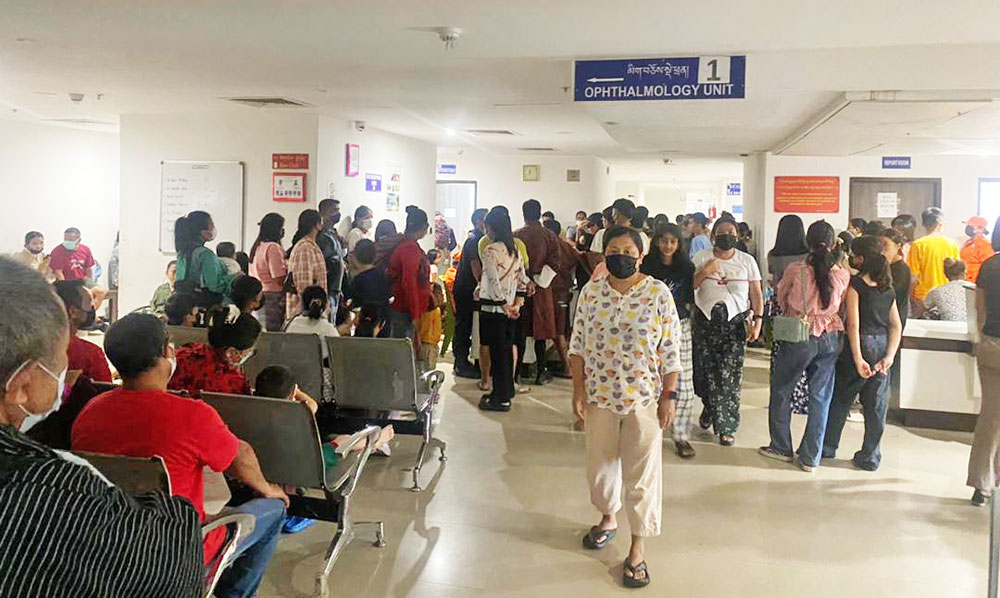Sherab Lhamo and Lhakpa Quendren
The Royal Centre for Disease Control (RCDC) recorded 3,081 cases of conjunctivitis from eight dzongkhags in August alone.
The first outbreak was reported in Phuentsholing Hospital; within a week, Phuentsholing recorded over 700 cases.
The outbreak in Phuentsholing began in July, coinciding with the reopening of schools. Chief Medical Officer of Phuentsholing Hospital, Dr Dorji Tshering, said, “Before the symptoms even start, people start becoming infectious.”
In addition, crowded places like schools and institutions provide a perfect breeding ground for the virus, due to which the students and even teachers within the institutions act as vehicles to spread the virus. Another factor was students’ poor handwashing habits.
Conjunctivitis, commonly referred to as pink eye or red eye, affects the outer membrane of the eyes and has been reported in various health centers including Chukha, Samtse, Sarpang, Tsirang, Samdrupjongkhar, Lhuentse, Dagana, and Pemagatshel.
It can be caused by viruses, bacteria, or allergies. The most commonly reported symptoms were redness, itchiness, photophobia, a gritty sensation, and discharge from the eyes. Patients also presented with fever, headache, and cough in some cases, said RCDC Head, Dr Sonam Wangchuk.
According to Karma Wangchuk, ophthalmic tech assistant at Nganglam Primary Health Centre, in a day, more than 10 patients came in due to conjunctivitis. In August alone, they recorded 78 patients.
He said that it all started in the second week of August, stating that the outbreak happened when individuals traveled to Nganglam from Phuentsholing.
Since the outbreak on August 7 in Sarpang, 1,434 people with conjunctivitis have visited the Gelephu Central Regional Referral Hospital (CRRH). Between August 14 and 16, the hospital recorded the most number of daily cases, between 280 and 229 patients.
Medical Superintendent of CRRH, Dr Choeda Gyaltshen, said that test results from the hospital laboratory have confirmed that the sample is a mixture of both bacterial and viral causes. The outbreak has also spread to the schools in the dzongkhag.
In the past, outbreaks remained localised and disappeared by themselves. This year it has spread to many dzongkhags and is sustaining. The incubation period for the virus takes place within three days, and in the case of bacteria, it takes 24 to 48 hours, said Dr Dorji Tshering.
Adding that if a person gets infected, on day one, it starts showing symptoms on day three, whereas the infectious period would have started around day two before the symptoms are shown.
Dr Dorji Tshering said that the virus spreads before showing any symptoms, making it challenging to contain the spread. It can be transmitted through close contact, touching, coughing, and sneezing. As it spreads mostly among students, it also indirectly spreads to their family members.
Dr Choeda said that many people infected with conjunctivitis are not showing up at the hospital.
The majority of those seeking medical treatment, he said, are employees and students, as they have to take leave from their work. “It is not feasible for them to go to work or school and would recover only after three days.”
RCDC is monitoring the situation and providing recommendations to the health centers that are reporting conjunctivitis cases. The medical teams at the health centers are investigating cases, particularly in schools, and isolating students with symptoms, providing symptomatic treatments and health education.
Phuentsholing Hospital also advised schools to let students take a minimum of three days’ rest at home. From the initial week of the outbreak, they have regularly communicated with health coordinators via a dedicated Telegram group consisting of coordinators and health officials. They have shared a one-page infographic with details of symptoms, prevention, and other details.
These were also shared in regional health sector groups consisting of all the sector heads and regional heads to share with their families and offices.
“Many healthcare professionals, including those working at the ophthalmology department, have contracted infections. However, the delivery of health services remains unaffected,” said Dr. Choeda Gyaltshen.
To prevent the spread of conjunctivitis, people are advised to avoid rubbing or touching their eyes frequently, avoid sharing personal items, regularly wash their hands with soap and water, and avoid close contact with people who are infected with conjunctivitis.
To prevent the spread of the infection, people are also advised to use eye drops or ointments prescribed by doctors and follow other recommended guidelines.
With the rising number of patients seeking medication for red eye, more de-suups were deployed at both the hospital entrance and the eye department. The current rise in patient visitors has also led to a higher workload for the eye department in Gelephu.
The most commonly reported cases are of suspected viral conjunctivitis based on clinical examinations. However, they have not performed laboratory confirmation tests.
RCDC plans to conduct viral testing for cases. Meanwhile, they are still waiting for reagents-chemical analysis.


